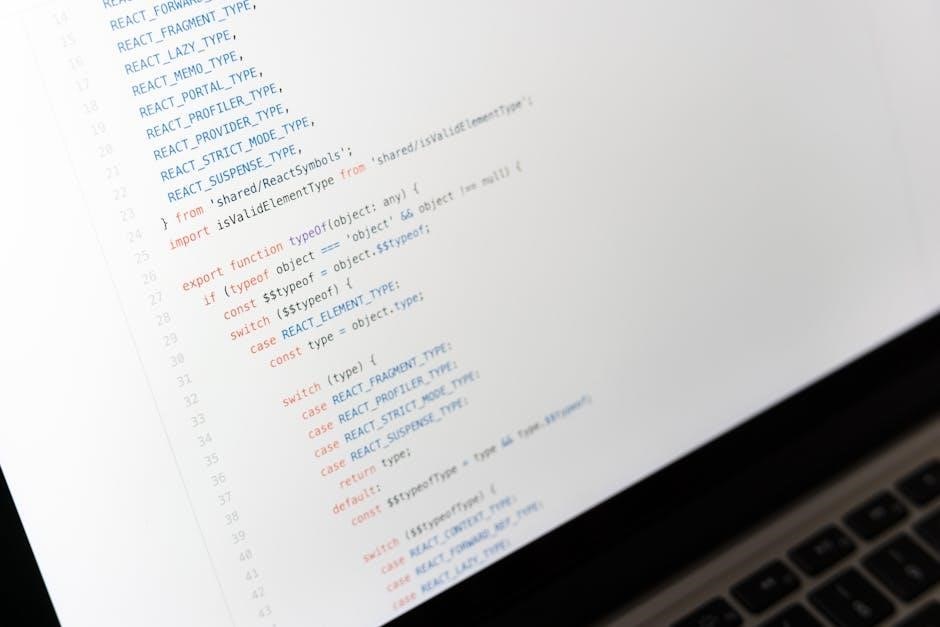Bosch Heat Pump Error Codes: A Comprehensive Guide
Welcome to a comprehensive guide on Bosch heat pump error codes. This resource aims to provide you with valuable information regarding understanding, troubleshooting, and addressing common error codes in your Bosch heat pump systems.
Bosch heat pumps, known for their efficiency and reliability, sometimes display error codes. These codes are crucial indicators of potential issues within the system. Understanding these codes is the first step in maintaining your heat pump’s performance. This guide will provide information on common Bosch heat pump error codes, their meanings, and basic troubleshooting steps.
Whether you’re a homeowner or a technician, this information will help you diagnose and address issues effectively. Remember to always consult your Bosch manual for model-specific codes and safety precautions. This guide is designed to help you navigate the world of Bosch heat pump error codes.

Understanding the Importance of Error Codes
Error codes are essential for diagnosing Bosch heat pump issues. They provide a quick way to identify problems, enabling faster troubleshooting and efficient repairs, thus minimizing downtime.
Why Error Codes Matter for Bosch Heat Pump Maintenance
Bosch heat pump error codes are vital for effective maintenance because they act as an early warning system, alerting homeowners and technicians to potential issues before they escalate into major problems. Addressing these codes promptly can prevent costly repairs and extend the lifespan of the heat pump. Furthermore, understanding error codes helps in maintaining optimal efficiency, ensuring the system operates within its designed parameters. This proactive approach not only saves money on energy bills but also contributes to a more comfortable and consistent indoor climate. Regular monitoring of error codes, coupled with scheduled maintenance, is key to reliable performance.
How to Access Error Codes on Your Bosch Heat Pump
Accessing error codes on your Bosch heat pump typically involves checking the unit’s display panel. Many models feature a digital interface that shows error codes directly when an issue arises. Consult your specific Bosch model’s user manual for precise instructions, as the method can vary. Some units may require pressing specific buttons or navigating a menu to reveal the error code. Additionally, some advanced systems might offer remote access via a smartphone app or web interface, allowing you to view error codes remotely. Always ensure you have the model number handy when consulting the manual or contacting customer support for assistance.

Common Bosch Heat Pump Error Codes and Their Meanings
Understanding common Bosch heat pump error codes is crucial for effective maintenance. Codes like E01 (Low Pressure) and E02 (High Pressure) indicate system issues needing attention.
E01: Low Pressure Fault
The E01 error code on a Bosch heat pump signifies a low-pressure fault within the system. This condition often arises due to insufficient refrigerant levels, potentially caused by leaks in the refrigerant lines or components. Addressing this issue promptly is essential to maintain optimal heat pump performance.
A low refrigerant charge can lead to reduced cooling or heating capacity, increased energy consumption, and potential damage to the compressor. It’s advisable to engage a qualified HVAC technician to diagnose the source of the leak, repair it, and recharge the system with the appropriate amount of refrigerant. Ignoring this error can lead to more costly repairs.
E02: High Pressure Fault
The E02 error code on a Bosch heat pump indicates a high-pressure fault, suggesting that the refrigerant pressure within the system is exceeding the normal operating range. This situation can arise from several factors, including a blocked or dirty air filter restricting airflow across the indoor coil, overcharged refrigerant levels, or a malfunctioning compressor.
Addressing a high-pressure fault promptly is crucial to prevent damage to the heat pump’s components, particularly the compressor. Over time, excessive pressure can lead to premature wear and tear, reduced efficiency, and costly repairs. It’s recommended to consult with a qualified HVAC technician to diagnose and resolve the underlying cause of the high pressure.
E03: Compressor Temperature Too High
The E03 error code for Bosch heat pumps signifies that the compressor’s operating temperature has exceeded the acceptable threshold. This overheating can stem from various issues, such as insufficient airflow across the condenser coil due to dirt or debris, a failing compressor motor, or a refrigerant charge that is either too low or too high.
A high compressor temperature can lead to significant damage, including premature failure of the compressor itself. Addressing this issue promptly is essential to maintaining the longevity and efficiency of your Bosch heat pump. It is advisable to engage a certified HVAC professional to properly diagnose and resolve the underlying cause.
E2: Communication Error Between Indoor and Outdoor Units
The E2 error code on a Bosch heat pump indicates a communication failure between the indoor and outdoor units. This disruption can arise from several potential causes, including wiring issues, loose connections, or a malfunctioning control board in either the indoor or outdoor unit. It could also indicate a problem with the data transmission itself.
Troubleshooting this error involves checking the wiring connections between the units, ensuring they are secure and free from damage. Also, inspecting the control boards for any signs of damage, such as burnt components. If the problem persists, it may need a technician to properly diagnose and repair.

Specific Bosch Model Error Codes
Different Bosch heat pump models have unique error codes. We will explore model-specific codes, such as those for the IDS 2.0 and Climate 5000 series, with their specific meanings and troubleshooting.
Bosch IDS 2.0 Error Codes
The Bosch IDS 2.0 series heat pumps are known for their efficiency. However, like all systems, they can experience issues indicated by specific error codes. These codes are essential for diagnosing problems and ensuring optimal performance. Key errors include those related to pressure faults, compressor issues, and communication problems between units.

For example, the IDS 2.0 service manual outlines fault codes related to temperature sensors (EC 54, EC 56), offering insights into resolving these issues. Understanding these codes allows for targeted troubleshooting, potentially saving time and money on repairs. Always consult the official Bosch documentation for accurate interpretations. Proper diagnostics are crucial for maintaining the longevity and efficiency of your IDS 2.0 system.
Bosch Climate 5000 Series Error Codes
The Bosch Climate 5000 series ductless air conditioner and heat pump systems also utilize error codes to communicate operational issues. These codes can vary depending on whether it is a single-zone or multi-zone setup. Common error codes indicate problems such as communication failures, temperature sensor malfunctions, or internal heater faults.
For instance, an error might point to a temperature sensor issue at T4 (outside temperature) or TP (compressor discharge pipe). When encountering an error, resetting power to the breaker for 30 seconds is a preliminary step. If the problem persists, consulting Bosch Customer Support at 1-800-944-2904 and the service manual is recommended for further assistance and detailed troubleshooting.

Troubleshooting Common Error Codes
Addressing common error codes promptly can restore your Bosch heat pump’s functionality. Start by identifying the error, consulting manuals, and performing basic checks before seeking professional help.
Troubleshooting Communication Errors (E2)
Communication errors, often indicated by the E2 code, signify a disruption in the connection between the indoor and outdoor units of your Bosch heat pump. Begin troubleshooting by inspecting the wiring connections between the units, ensuring they are secure and free from damage.
Verify the power supply to both units, checking breakers and fuses for any issues. A voltage issue may be causing the communication breakdown. Resetting the system by turning off the power at the breaker for about 30 seconds can sometimes resolve temporary glitches. If the error persists, consult the Bosch service manual for model-specific troubleshooting steps. It might also indicate a faulty control board in either the indoor or outdoor unit, necessitating professional diagnosis and potential component replacement.
Addressing Low Pressure Faults (E01)
The E01 error code signals a low-pressure fault within your Bosch heat pump system, typically indicating a refrigerant leak or insufficient refrigerant charge. Begin by visually inspecting the refrigerant lines and connections for any signs of leaks, such as oil residue.
If a leak is suspected, it’s crucial to contact a qualified HVAC technician to locate and repair the leak, as handling refrigerant requires specialized equipment and expertise. Avoid attempting to recharge the system yourself, as improper handling can cause further damage. Ensure the technician uses the correct type and amount of refrigerant specified for your Bosch model, referring to the unit’s service manual for accurate specifications. A thorough system check after the repair is vital to confirm proper operation and prevent recurrence.

Advanced Troubleshooting and Repair
When basic troubleshooting fails, advanced diagnostics are needed. This section covers contacting Bosch support, interpreting sensor errors (EC 54, EC 56), and emphasizing the importance of professional assistance for complex issues.

When to Contact Bosch Customer Support (1-800-944-2904)
It’s crucial to know when a DIY approach should be abandoned and professional help sought. Contact Bosch Customer Support at 1-800-944-2904 immediately if you encounter error codes not listed in your manual or online resources, as they may require specialized technician assistance.
Specifically, if the error codes E9, H0, or E5 appear intermittently and the system returns to normal function after a power cycle, continued monitoring is acceptable. However, if these errors persist or become more frequent, a service call is necessary.
If you are not experienced with HVAC systems, contacting support is crucial. Electrical hazards and refrigerant leaks can be dangerous. Always prioritize safety and seek professional assistance when in doubt.
Interpreting Temperature Sensor Errors (EC 54, EC 56)
Temperature sensor errors, such as EC 54 and EC 56, indicate issues with specific sensors within your Bosch heat pump. EC 54 typically points to a problem with the outside temperature sensor (T4), while EC 56 suggests an issue with the compressor discharge pipe sensor (TP).
When these errors appear, it’s essential to check the sensor wiring for any damage or loose connections. Also, inspect the sensors themselves for physical damage. In some cases, the sensors may need replacement.
If the wiring and sensor appear fine, the problem might reside in the control board. Resolving these errors often requires a multimeter to test sensor resistance and voltage levels, ensuring they fall within the manufacturer’s specifications. If unsure, contact Bosch support.

Preventative Maintenance to Reduce Error Codes
Regular preventative maintenance on your Bosch heat pump is crucial for minimizing error codes. Consistent care ensures optimal performance and can prevent costly repairs down the line, extending the system’s lifespan.
Regular System Checks and Maintenance Tasks
Performing regular system checks and maintenance tasks is paramount to ensuring your Bosch heat pump operates efficiently and minimizes the occurrence of error codes. These checks should include inspecting the unit for any visible damage, such as leaks or corrosion, and ensuring all components are securely fastened. Monitoring the system’s performance, paying attention to unusual noises or temperature fluctuations, can help identify potential issues early on.
Additionally, cleaning the outdoor unit’s coils and removing any debris that may obstruct airflow is crucial for maintaining optimal heat exchange. Regularly inspecting and cleaning the blower motor and fan blades can prevent overheating and improve system efficiency. It’s also important to verify that the refrigerant levels are within the recommended range, as low refrigerant can trigger error codes related to pressure faults. A comprehensive approach to maintenance will contribute significantly to the longevity and reliable performance of your Bosch heat pump.
Importance of Clean Filters and Proper Airflow
Maintaining clean filters and ensuring proper airflow are critical aspects of Bosch heat pump maintenance, directly impacting its efficiency and the likelihood of encountering error codes. Clogged or dirty filters restrict airflow, forcing the system to work harder to maintain the desired temperature, leading to increased energy consumption and potential overheating. Restricted airflow can also cause the evaporator coil to freeze, resulting in reduced heating and cooling capacity, and possibly triggering error codes related to low pressure or compressor issues.
Regularly replacing or cleaning air filters, typically every one to three months depending on usage and air quality, is essential. Ensure that vents are not blocked by furniture or other obstructions, allowing for unrestricted airflow throughout your home. By prioritizing clean filters and proper airflow, you’ll not only improve the performance and lifespan of your Bosch heat pump but also reduce the risk of encountering common error codes, ensuring consistent and efficient operation.

Using Bosch Manuals for Error Code Information
Bosch manuals are essential resources for understanding error codes. They provide detailed explanations, troubleshooting steps, and specific information related to your heat pump model.
Accessing Bosch IDS 2.0 Service Manuals (PDF)
Accessing the Bosch IDS 2.0 service manuals in PDF format is crucial for technicians and homeowners seeking detailed information about their heat pump systems. These manuals contain comprehensive troubleshooting guides, error code definitions, and repair procedures specific to the IDS 2.0 model. You can typically find these manuals on the official Bosch Thermotechnology website or through authorized distributors.
The PDFs often include detailed diagrams, electrical schematics, and step-by-step instructions that are invaluable for diagnosing and resolving issues. Ensure you have the correct model number before downloading to guarantee the information matches your specific unit. These manuals are essential for proper maintenance and repair.
Finding Error Code Information in Installation Manuals
Installation manuals for Bosch heat pumps are a valuable resource for finding error code information. These manuals typically include a section dedicated to troubleshooting, which lists common error codes and their corresponding meanings. This section often provides basic steps for diagnosing and resolving the issue, offering a first line of defense for homeowners and technicians.
These manuals are usually included with the unit upon purchase and can also often be found online on the Bosch website. They provide essential information for understanding the system’s operation and addressing potential problems. Always refer to the specific manual for your model to ensure accurate troubleshooting.
Understanding Bosch heat pump error codes is crucial for maintaining efficient operation. Regular maintenance and prompt attention to errors will ensure long-term reliability and performance of your system.
The Role of Error Codes in Efficient Operation
Error codes in Bosch heat pumps are more than just cryptic messages; they are critical diagnostic tools that play a pivotal role in ensuring efficient operation. These codes provide immediate feedback on the system’s health, alerting users and technicians to potential problems before they escalate into major failures. By promptly addressing error codes, you can prevent energy waste, reduce repair costs, and extend the lifespan of your heat pump.
Ignoring these warnings can lead to decreased performance, increased energy consumption, and potentially costly repairs. Understanding the meaning behind each code allows for targeted troubleshooting and maintenance, optimizing the system’s efficiency and ensuring consistent comfort in your home.
